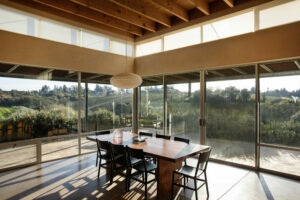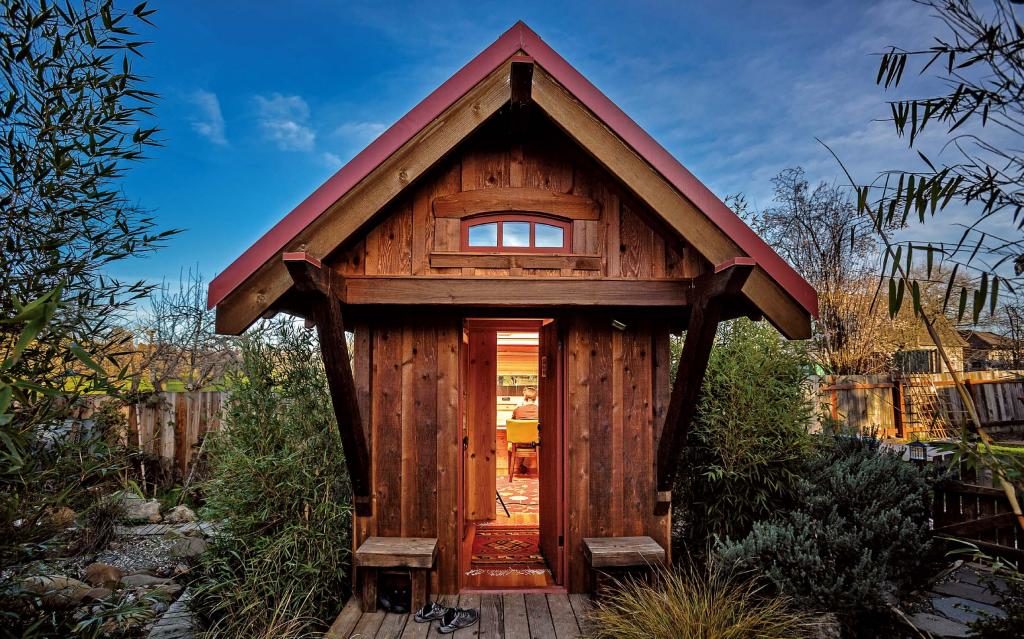Ella Jenkins wakes up nearly every morning in a 120-square-foot Cypress 18 Tumbleweed Tiny House that she built herself on the Sonoma Coast.
“It feels amazing, absolutely delightful,” she said of the space she shares with her boyfriend and their dog, a 55-pound mutt they rescued a few months ago. “I’ve always loved small spaces, and in a tiny house everything is so close. I burn fewer dinners and I don’t lose things.”
But what about clothes and shoes? Do you have to eschew fashion to live in such a small space?
“I was the kind of person who would buy something and then not wear it,” she said. “Now I have none of the guilt of buying too much. I only have things I need and love.”
She has three pairs of shoes: two pairs of boots for daily wear and one pair of high-heeled boots.
The 23-year-old harpist paid for her house by busking (playing in public spaces) in Scotland. Her harp is the first thing she sees when she walks into her little home, with a view of the ocean beyond it. She still busks for tips, though cautiously, because many local ordinances prohibit it.
Her coastal house fully paid for, Jenkins works just two weekends a month, conducting workshops for Tumbleweed Tiny House Co. The rest of her time is spent knitting, making jewelry, drawing, painting and playing music. Time — the way you spend it and the way you think of it — shifts when you don’t have a monthly mortgage or rent payment.
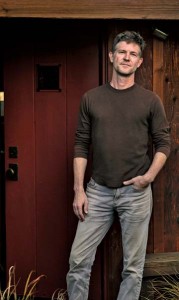
Jay Shafer, the visionary who founded Tumbleweed Tiny House in Sebastopol the late 1990s, explained that a tiny house isn’t so much small as it is essential.
“It is simply a well-designed home, with all of the unnecessary parts edited out,” he said. “Everything is boiled down to its essence.”
For Shafer, that essence is a convergence of necessity and beauty. As the scale of a structure shrinks, he said, the significance of everything is magnified. The alignment of each element, even the smallest of details, must serve the overall vision and purpose, which is to create a home that is every bit as wonderful, comfortable and nourishing, if not more so, than a much larger house.
But there’s something else, too: a touch, perhaps, of magic, a reflection of Shafer’s passion for meaning.
“I was working on a house that had 145 square feet of space,” he offered by way of explanation. Local building codes required a minimum of 150 square feet, yet to add 5 square feet to his design would destroy its overall economy and alchemy. He solved the problem by putting the house on wheels, as building codes apply to structures, not vehicles.
Over the years, Shafer has honed his design skills in unusual ways. He’s stood in public bathroom stalls, pondering the feasibility of installing a functional kitchen in such a small space. To perfect sleeping lofts in his houses, he’s spent time sitting under tables to assess the feel of the headroom.
He also thinks a lot about downsizing, about what items and objects people need, what they think they need and what is hardest to give up. Shafer lives in a 125-square-foot house in Graton; in front of the little abode is a 500-square-foot structure he calls the bunk house, where he, his wife and their two young sons sleep.
Not quite two years ago, Shafer sold Tumbleweed to a partner, Steve Weissmann. Their design aesthetics were diverging, he said, and he was focusing on new designs and projects.
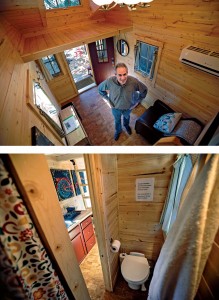
During Shafer’s time at Tumbleweed, the company developed plans for several styles of tiny houses and sold them to do-it-yourselfers. He built a few houses, but mostly worked with those who wanted to construct their own. Many started blogs about the process and it didn’t take long before “Tumbleweed” became the generic term for tiny houses throughout the country.
“We seem to be the Kleenex of the tiny-house movement,” said Debby Richman, marketing director for Tumbleweed, referring to the use of the best-known manufacturer’s brand name for all facial tissues.
Weissmann moved the company’s offices to Sonoma, not far from the town plaza, and began to expand the business, especially its construction side. An Amish family in Colorado Springs, Colo., now manufactures the homes. In the first year after the sale, Tumbleweed delivered more than two dozen little houses and this year expects to move 100. It also sells plans and holds seminars nationwide.
An in-house architect, Meg Stephens, has added new designs to the original Tumbleweeds and lives in one in Sonoma that she and her husband built last winter. The company has incorporated a number of requests into its design options and codified many of them, such as stairs instead of a ladder to get to the sleeping loft and dormers in the loft itself to make it more spacious without altering the home’s overall footprint.
As Tumbleweed has expanded, it has attracted a huge array of people looking for something other than a primary residence, though there is plenty of interest in living in tiny houses, too. Individuals are attracted to the mobility of the homes, their small ecological footprint and the freedom of not having a mortgage. At the same time, traditional homeowners are interested in tiny houses as vacation homes, guest houses, caregiver homes, home offices, art studios and backyard hideaways for youngsters.
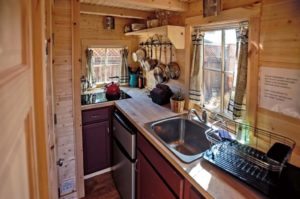
Not far from the company’s office is a 131-square-foot Tumbleweed that can be rented for the night by vacationers and prospective tiny-house buyers. For those who want a Tumbleweed of their own, base prices range from $57,000 for 18-foot models to $66,000 for 24-foot models.
Today, nearly all tiny houses are constructed on wheels, with permanent trailer hitches. Tumbleweed houses have a small air conditioning and heating unit attached above the trailer hitch which, when it is not connected to a vehicle, can hold a propane tank.
Shafer, whose new company is Four Lights, builds all of his new designs on wheels, too.
One of the benefits of wheels instead of cement foundations is that the structures are classified as recreational vehicles, which provides a range of benefits, from financing and insurance to zoning. Although some communities restrict how long an RV can remain parked at a specific location, cities are reconsidering such restrictions. In Sonoma, for example, it is now legal to have a tiny house on wheels year-round if a caregiver lives in it.
Tiny houses aren’t just mobile, they’re durable and efficient.
Tumbleweed makes its houses to last a minimum of 50 years. They need power and water, of course, and there are several options. A tiny house can tap into the grid with electrical, water and sewer or septic hookups, or can be entirely self-contained, using propane, a composting toilet, water tank and, in a long-term location, solar panels adjacent to the house.
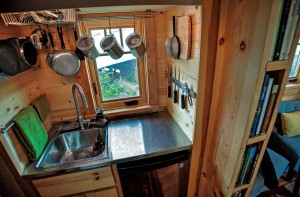
Shafer’s new company features six designs for tiny houses. He’s expanded to offer ready-made houses and hopes manufacturing will begin sometime this year, by a company in New Hampshire. He’s not yet established the final price of his manufactured Four Lights houses; materials estimates for do-it-yourselfers range from $8,450 to $30,400 and include heaters, appliances and other components.
Shafer has also developed plans for a village of tiny houses called the Napoleon Complex, which he jokingly refers to as co-housing for the anti-social, though really, he’s simply focused on perfectly designed private spaces combined with an opportunity to share certain necessities.
“You can share resources like washers, dryers and lawn mowers,” he said, adding that this is not traditional co-housing. “There will be no community meetings,” he emphasized.
Although Shafer envisions 16 to 22 tiny houses per acre, he likely will begin with a community of eight to 16 houses, for a total of 20 residents. People will own their own houses and the little plots of land they sit on, and share the expense of the common area.
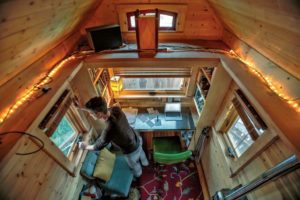
Tiny houses have broken through to the mainstream. One sees them in the Deep South, where they began to appear after Hurricane Katrina, though they tend to be most popular where high housing prices intersect with innovative thinking.
There are movements in Portland, Ore., and Boston, with requests for seminars coming from all over the country. Yet Sonoma remains the nexus of the little-house movement.
“Tiny-house proselytizers tend to be from Sonoma County,” Tumbleweed’s Richman said, calling its residents thought leaders and early adopters.
For them, living in a small space is living large.



